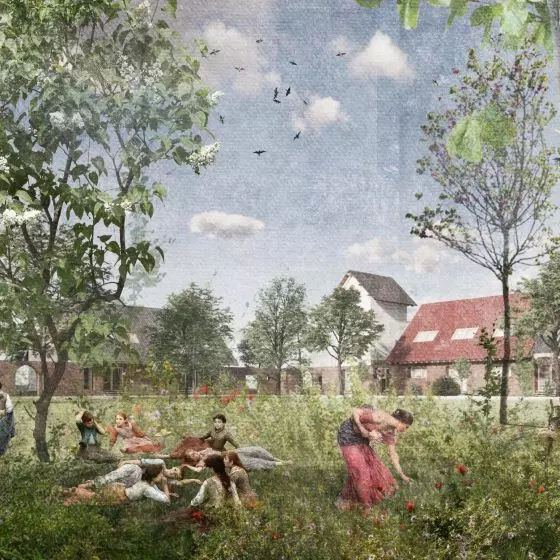Viktoria Bagińska, Roman Michalczak and Zofia Napiontek from the Magdalena Abakanowicz University of Arts in Poznań received an honorable mention in the international competition Adaptive Reuse × Placemaking. Their project involves adapting and revitalizing a historic monastery in Spain by giving it new functions including a concert hall and an open space for integration. The students used versatile modules for construction, creating a system of footbridges and independent internal structures.
The Adaptive Reuse × Placemaking competition organized by the Never Enough Architecture Foundation in cooperation with the municipality of Pelayos de la Presa in Spain was preceded by a free course. During the course, participants were able to learn from experts how to adapt old buildings for new uses while preserving their unique look and character and reusing materials(adaptive reuse). By placemaking, on the other hand, the organizers meant creating better public spaces that focus on inclusivity, use and a sense of belonging.
The competition focused on a historic monastery in Spain
© Never Enough Architecture
blending history and modernity
The competition challenge was to bring life back into the historic monastery of Santa María la Real de Valdeiglesias in the village of Pelayos de la Presa. The challenge was to harmoniously combine history and contemporary design, environmental care and community involvement. The goal of the competition was to popularize the monastery and the nearby San Juan reservoir and encourage tourists to visit the site year-round.
The monastery is located in the village of Pelayos de la Presa
© Viktoria Bagińska, Roman Michalczak, Zofia Napiontek
The functional program was to include: an auditorium for 300 people, flexible exhibition spaces, inclusive zones for the community (workshops, markets, playgrounds, educational spaces), and pet-friendly spaces. In addition, participants were to consider adding amenities such as a café, restaurant area, relaxation zone, reading corners or interactive exhibition spaces. In addition, the program could be expanded to include landscaping of the green area surrounding the monastery.
The entries submitted for the competition were evaluated by a jury consisting of: Ma Yansong (MAD Architects), Antonio Sin Hernándes (Mayor of Pelayos de la Presa), Marcial Jesus and Javier Gonzalez (100architects), David Engwicht (Creative Communities),Francisco Latorre Navarro (Lacaton & Vassal Architectes), Hyunje Joo (Hyunje Joo_Baukunst studio), Mingzhu Bai and Antoine Nerval (Mingzhu Nerval studio), Maya Calleja (Gensler Shanghai).
projections of assumptions
© Viktoria Bagińska, Roman Michalczak, Zofia Napiontek
honorable mention for polish students
From the huge number of works submitted, the jury selected fifty finalists—ten received honorable mentions, two projects received special mentions, and three main prizes were awarded. First Prize went to a project by a team from Italy consisting of: Silvia Gronchi, Simone Parola. You can learn about all the awarded works on the competition website.
Among the honorable mentions, the only one from Poland was the project by UAP students from the Architecture and Design Department—Viktoria Bagińska, Roman Michalczak and Zofia Napiontek. The work was done under the direction of Szymon Januszewski.
The students also developed the monastery courtyard
© Viktoria Bagińska, Roman Michalczak, Zofia Napiontek
Our project focuses on creating an open space, conducive to integration and shared experiences. The facility is suitable for families, individuals, adults, children, seniors and people with disabilities. It is also pet-friendly, with a designated park-like area," the authors describe.
The students placed great emphasis on the relationship between indoor and outdoor spaces and openness to the landscape. Outside the walls of the monastery, they proposed new plantings of trees, shrubs and flowery meadows, with greenhouses to encourage visitors to participate in local gardening initiatives.
An idea for a monastery in Spain, axonometry
© Viktoria Bagińska, Roman Michalczak, Zofia Napiontek
universal module
Out of respect for the natural and historic character of the site, the young designers used a universal structural module made of steel and glass. It constitutes both the structure of the single-story pavilion, which serves as an "enclosed courtyard," the structure of the footbridges floating above the monastery, and the roof of the church.
diagram of the platforms and the +2 floor plan.
© Viktoria Bagińska, Roman Michalczak, Zofia Napiontek
The exterior-designed pavilion houses most of the administrative and technical functions, so that they do not have to be located in the historic monastery. Only the most important cultural functions—a concert hall in the church and exhibition spaces and footbridges in the ruins- are located in the former building. The module is mounted to the ground with anchors, and is repeatable and scaled according to the designed space.
The low ramps and glass floors used in the design (leaving a view of the historic floor) served to compensate for changes in ground elevation and improve accessibility to the site. The authors also kept an appropriate distance from the historic walls of the monastery. This is in order to leave them intact. The exception is the church's roof structure, which was fixed into the existing historic walls.
The authors focused on creating an open space conducive to integration and shared experiences
© Viktoria Bagińska, Roman Michalczak, Zofia Napiontek
cultural space
The implementation of the project for the Adaptive Reuse × Placemaking competition allowed us to apply the theory of contemporary historic preservation to practice. We learned how to design a social space, following the spirit of the times and adapting an old building for new functions [...]. Thanks to carefully executed conservation documentation, we were able to precisely identify design problems and seek solutions for them. The concept was preceded by many ideas, both in the form of the new structure and the location of functions. As a result, we were confident that the final form was the best. We are satisfied with the result of our work, because we know that as a team we have approached the adaptation of the monument with integrity, creating an interesting cultural space. We enjoyed working together very much, and learned how to constructively exchange ideas and positively discuss many aspects of our project," conclude Viktoria, Roman and Sophia.














































